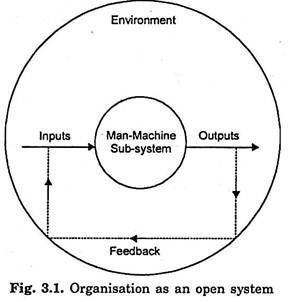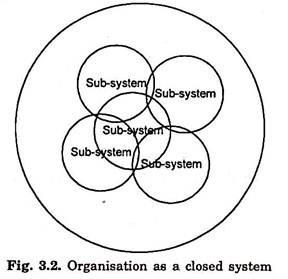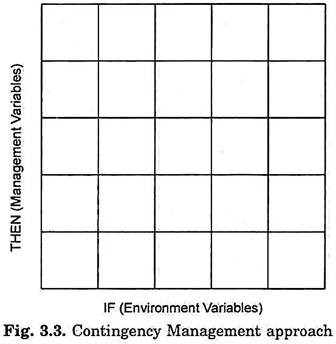Major schools of management thought may be classified as under: 1. Management Process School 2. Empirical School 3. Human Behaviour or Human Relations School 4. Decision Theory School 5. Mathematical or Quantitative Management School 6. Systems Approach to School 7. Contingency Approach.
Term Paper # 1. Management Process School:
The chief contributors belonging to this school are Henry Fayol, J.D. Mooney, A.C. Railey, Lyndall Urwick, Harold Koontz, William Newman and Mc Farland. According to this school, management can best be studied in terms of the process that it involves. The proponents of this view believe in the universality of management principles.
Essential features of process school are as follows:
i. Management is the study of functions of managers.
ii. The functions of managers are the same irrespective of the type of organisation.
iii. The conceptual framework of management can be built through an analysis of the process of management, viz.; planning; organising, staffing, directing and controlling are the core of management.
Uses of Process Approach:
i. Through knowledge of the functions/process makes one versatile in the art of management.
ii. This approach recognises management as a distinct discipline. It is easy to understand and practice.
iii. This approach recognises that management is universal irrespective of the types of organisations or the levels of organisations.
iv. It integrates the knowledge of various disciplines to better management for a better tomorrow.
v. It is an aid to the professionalisation of management.
vi. It provides flexibility and there is room for innovation, research and development.
vii. It recognises that management is both art and science.
viii. The elements of management and its principles are true even if a practising manager chooses to ignore them in a particular situation.
ix. It provides a helpful and purposeful philosophy of management.
x. It involves the performance of functions by managers aiming at proper and systematic utilisation of resources.
Term Paper # 2. The Empirical School:
The main contributors to this approach are Ernest Dale, Mooney, Railey, Urwick and others. This school believes that by analyzing the experience of successful managers or the mistakes, we somehow learn about applying the most effective management techniques. This school is also called as customs school.
The main features of this school are:
i. Management is the study of managerial experiences.
ii. The managerial experience can be passed over to the practitioner and students.
iii. The techniques used in successful cases can be used by future managers.
iv. Theoretical research can be combined with practical experiences.
Term Paper # 3. Human Relations School:
This school takes particular note of psychological factors underlying the human behaviour in organized groups under the given situation. It is based upon the fact that the managing involves getting things done with and through people; therefore, management must be centred on inter-personal relations.
The range of thought in this school goes from:
i. Human relations and how the manager can understand and use this understanding,
ii. The manager as a leader and how he should lead to, and
iii. A study of group dynamics and inter-personal relationships.
The main thinkers subscribing to this school are Elton Mayo, McGregor, Keith Davis and others.
The main features of this school are:
i. This approach draws heavily its concepts from psychology and sociology.
ii. According to this school, management is getting things done through people; hence managers should understand human relations.
iii. Motivation, leadership, communication, participative management and group dynamics are the core of this approach.
iv. Management must study interpersonal relations among people.
v. Greater production and higher motivation can be achieved only through good human relations.
Term Paper # 4. Decision Theory School:
This school concentrates on rational decisions—the selection of a suitable course of action from various possible alternatives. This approach may deal with the decision itself or with the persons or with the organisational groups who make the decision and with an analysis of the decision process.
The scientific approach to decision making involves consideration of these factors:
i. Defining the problem,
ii. Collect all relevant information,
iii. Indicate alternatives,
iv. Examine all of the alternatives and the solutions,
v. Test of solutions,
vi. Select a course of action,
vii. Implement the action, and
viii. Evaluate the result of action.
The main features of this school are:
i. Management is essentially decision making.
ii. The members of the organisation are decision makers and problem solvers.
iii. Decision making is the central point in management.
iv. For increasing the organisational efficiency, the quality of decisions is a prime factor.
v. Management information system and the process and technique of decision making form the subject matter of the study of management according to this school of thought. The main contributors and thinkers belong to this school are Chester Bernard, James March, Herbert Simon, Richord Cyert and others.
Term Paper # 5. Mathematical or Quantitative Management School:
The contributors of this school see management as a system of mathematical models and process. This group believes that if management, or organisation, or planning or decision making is a logical process, it can be expressed in terms of mathematical symbols and relationship. This approach forces the analyst to define a problem area, allow for the insertion of symbols for unknown data and through logical methodology provides a powerful tool for solving complex problems.
Essential features of mathematical school are:
i. Management is concerned with problem solving and it must make use of mathematical tools and techniques for the purpose.
ii. The different factors involved in management can be quantified and expressed in the form of models.
iii. Operational research, mathematical tools, simulation and model building are the basic methodologies developed by this school of thought.
iv. Management problems can be described in mathematical symbols.
Term Paper # 6. The Systems Approach School:
This school of recent origin having developed in late 1960’s. It is an integrating approach which considers the management in its totality based on empirical data. According to this approach, attention must be paid to the overall effectiveness of the system rather than the effectiveness of a subsystem in isolation from the subsystem. The main emphasis is on the interdependence and interrelatedness of the various sub-systems, from the point of view of the effectiveness of a large system.
The main contributors of this school are Kenneth, Boulding, Johnson, C. W. Churchman and others:
The main features of this approach are:
i. A system has a number of sub-systems, parts and sub-parts.
ii. All the subsystems, parts and sub-parts are mutually related to each other. This relationship is in the context of the whole and is very complex. A change in one part will effect changes in others.
iii. The systems approach to management brings out the complexity of a real life management problem much more sharply than any of the other approaches.
iv. The systems approach emphasizes the study of the various parts in their interrelationships rather than in isolation from each other.
v. It can be utilised by any other school and management Thought.
vi. The boundary of a system may be classified into two parts:
(a) Open System:
Open system is an input output system which has continuous interaction with its environment. Such a system takes inputs from the environment, transforms them into output and exports it to the environment. The functioning of the system is influenced by environmental changes.
The feedback mechanism in an open system enables the people to assess, adopt and adjust the system to the changing conditions of its environment and to exercise control over its operations. All living beings e.g., people, animals, plants can be considered as open system. Organisation itself is an open system if it is working.
(b) Closed System:
Here there is no interaction with the outside world. It is closed loop or self-contained entity with no external input. Physical and mechanical systems are close systems. Closed system cannot monitor changes occurring in the environment. Traditional organisation theorists regarded organisations as closed system while modern experts consider them open systems.
The systems approach has been utilized in studying the function of complex organisations. It has been used as the base for new kinds of organisations like the project management organisation. However, the problem with this method is its inter-complexity particularly when it comes to a study of large and complex organisation.
Term Paper # 7. The Contingency Approach:
This approach to management emphasizes the fact that management is highly practice oriented and action packed discipline. Managerial decisions and actions initiatives are to be matters of pragmatism and not of principles. The environment of organisations and managers is very complex, uncertain, ever-changing and diverse. It is the basic function of managers to analyze and understand the environment in which they function before adopting their techniques, processes and practices.
The choice of approaches as also their effectiveness is contingent on the behaviour and dynamics of situation variables. There is no universally valid one best way of doing things. Management theory and principles tend to be deterministic or dogmatic approaches. What is valid and good in a particular situation need not be so in some other situation.
Contingency approach has the following features:
i. Management action is dependent upon certain action outside the system or subsystem as the case may be.
ii. Organisational system should be based on the behaviour of action outside the system so that organisation should be integrated with the environment.
iii. Because of the specific organisation-environment relationship, no action can be universal. It varies from situation to situation.
The contingency approach can be expressed as “if then” relationship. “If’ denotes the independent variable environment while “then” stands for the dependent variable i.e., management action. This shows the contingent relationship between environment variables and management variables.
Contingency thinking helps managers in several ways in performing their functions of planning, organising, direction and control. It widens their horizons beyond the theory of management, its concepts, principles, techniques and methods. It helps them to broad base their approach from more technique orientation to problem situation orientation. It leads them to be sensitive, alert and adaptive to situation behavioural variables, while tailoring their approaches and styles.
It guides them to adopt open system viewpoints, to look at things and situations in an integrated and multidimensional manner and to get away from stereotypes. Contingency thinking enlarges the area of freedom of operation of managers. They are not handicapped by having to apply same methods, practices and processes to diverse situations, they can think of innovating new approaches or a blend of unknown approaches on the basis of their compatibility and context.
For example, different structural designs are valid for different strategic and tactical needs of organisations on the one hand and realities of the situations, on the other. Another example, as close supervision and control may be appropriate for some categories of employees and work situations, while general supervision will work better in some other situations.


